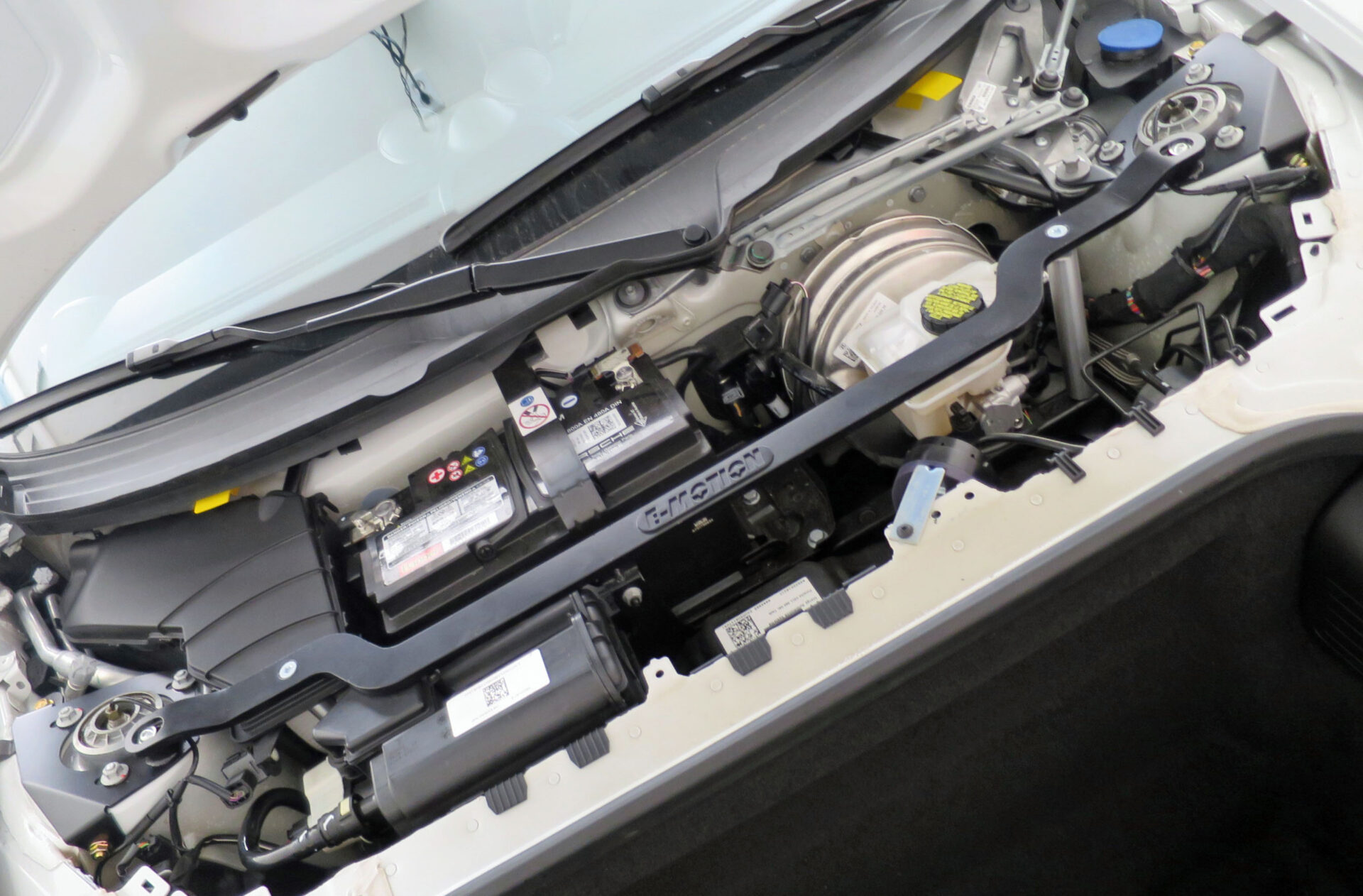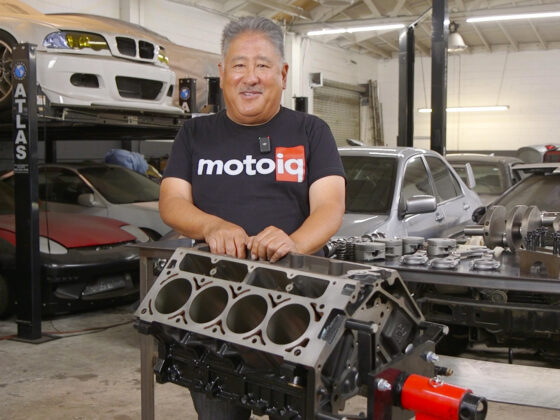 The front driver’s side fuse cover panel has two Velcro attachment points that are surprisingly hard to undo. I have the OBDLink MX stuffed up behind a wire harness bundle and zip-tied in place to prevent rattling noises.
The front driver’s side fuse cover panel has two Velcro attachment points that are surprisingly hard to undo. I have the OBDLink MX stuffed up behind a wire harness bundle and zip-tied in place to prevent rattling noises.
 I tapped power from the fuse location for the rearview mirror. I had to make a small cutout in the fuse holder housing to allow my 12V wire to sit below the cover panel.
I tapped power from the fuse location for the rearview mirror. I had to make a small cutout in the fuse holder housing to allow my 12V wire to sit below the cover panel.
 A quick test to make sure everything powered up correctly. This was actually the second test as I had messed up the wiring on the first test; I hacked the wrong wire in the ODB2 coupler connector for 12V power.
A quick test to make sure everything powered up correctly. This was actually the second test as I had messed up the wiring on the first test; I hacked the wrong wire in the ODB2 coupler connector for 12V power.
 The cover goes back on without any issues. You can see I have the OBD2 coupler plugged in.
The cover goes back on without any issues. You can see I have the OBD2 coupler plugged in.
 I was on my way to a track day and ran over something with the driver’s front tire at around 5am in the pitch black. The tire instantly went flat. I imagine it was some steel angle iron as it cut the wheel too. The tire goop and compressor weren’t going to help me here. Whatever it was took out a car before me as I pulled off to the side of the road behind him. I’m also very glad I had the brace installed.
I was on my way to a track day and ran over something with the driver’s front tire at around 5am in the pitch black. The tire instantly went flat. I imagine it was some steel angle iron as it cut the wheel too. The tire goop and compressor weren’t going to help me here. Whatever it was took out a car before me as I pulled off to the side of the road behind him. I’m also very glad I had the brace installed.
I can tell you with certainty that the E-Motion strut reinforcement brace has significantly increased the stiffness of the frontend of the car. Everything feels more solid. Going up Angeles Crest Highway, the front of the car was steadier over the bumpy stuff. More telling of the improved chassis stiffness is the improvement in NVH. After I installed the full E-Motion Engineering spherical suspension setup, I noted there was an increase in NVH. This actually caught me a bit by surprise because there was no increase in NVH after I went full spherical on the S2000. I attributed the difference due to differences in suspension geometries with the Honda having a double wishbone setup compared to the strut setup on the Cayman. Well, after the installation of the E-Motion strut reinforcement brace, the NVH in the car has been significantly reduced. I have noticed this because I drive on really crappy roads daily and I noticed the ride got smoother and quieter going over rough roads. This is similar to when I installed fender braces on the S2000 and the convertible roof latch rattle was eliminated. A stiffer chassis is better for everything in a car. I consider the E-Motion strut reinforcement brace a no-brainer modification to improve the ride quality, handling, and robustness of the applicable Porsche cars.




11 comments
Shame they didn’t double bolt the bar. The bar can only handle tension and compression and no bending moment as designed.
Spoke too soon. My bad. Nice tie in to the subframe. Didn’t see it initially.
Yup, it’s a super beefy support bar for the heavy factory battery. Quick search shows the factory battery is about 45 lbs.
Strut/shock tower loads are basically vertical-a horizontal bar does little but add weight.
Remember this is a strut setup, so lateral loads are transmitted into to strut towers. Notice Porsche has black bars going from the strut towers to the rear bulkhead to add strength. Uneven vertical loading, from bumps or cornering, will try to twist the chassis and a rigid horizontal bar can add some resistance against that twisting. This particular design from E-Motion ties the horizontal bar to the strong battery brace that runs the span of of the chassis, boxing it in. Additionally, by tying down the horizontal bar to the battery brace bar, it’s clamping down on the top of the strut towers to help resist the vertical loads which have lead to strut tower failure on this chassis.
Lateral loads at the top of the strut are quite light as most lateral loading goes through the lower arm to the chassis.
I’ll calculate some approximate numbers. My car is about 3000lbs with 45%/55% weight distribution and I’ve pulled 1.4G lateral. At max lateral G, we can assume the inside front tire is not loaded to simplify the napkin calculation. I assumed the control arm is 6″ above ground and the strut tower is 24″ above ground. Crunching the numbers, it’s about 1890lbs at the tire contact patch, 2520 lbs at the control arm joint, and 630lbs at the strut tower. Those are all the lateral loads. Remember, there’s still the vertical load on the strut tower that’s about 1350lbs. And that vertical load is trying to cause displacement of the strut tower relative to the other strut tower; i.e. twisting the chassis. And the E-motion brace setup resists that vertical displacement and lateral loads. If you didn’t already look up GT4 strut tower failures, go ahead and look.
Photos of the strut tower failure imply a vertical component caused the failure, not a lateral load. Vertical loads are considerable when the suspension is fully compressed. That bar you are hawking does nothing for vertical loads.
Of course it’s a vertical load that causes the failure of the strut tower. And I mentioned that in the article when I mentioned sharp impacts. I would note, I never asked E-Motion for any type of discount and they didn’t even know I was writing an article on the reinforcement brace; so, I’m not ‘hawking’ anything. Same goes for their suspension components; I paid full price including the installation costs.
And of course the brace system counteracts vertical loads. Even if it were just the bar alone, it would have some resistance to vertical loads because the bar attaches to the strut tower cap piece as a rigid joint which resists bending, as opposed to many bars that have a heim joint that would rotate. But what really helps this brace system resist the vertical loads are the two vertical posts that tie the bar to the battery sub brace. Those two posts are fastened with M8 size fasteners; you could lift the front of the vehicle from the E-motion brace because of how the braces uses the vertical posts to tie to the chassis.
Go ahead, draw out the free body diagram and analyze the loads and interactions.
You’re the one selling something. You draw a diagram and be sure to include the CG, roll center, and wheel diameter this time. You left out those items in your last calculation.
Selling would imply I’m getting something of value in return, which I’m not. You’re the one who made a blanket statement, “Lateral loads at the top of the strut are quite light” without providing any quantitative value. So, I did a quick estimation using some values specific to my car. If you don’t like my simplified calculation, then do your own work and show it in order to provide a value that backs up your statement.
You said the bar does nothing for vertical loads. I described how the brace system does counteract the loads. If you dispute my analysis, draw it out and prove it.